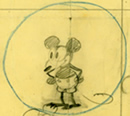The Walt Disney Family Museum opened its doors for the first time Thursday. Founded by Walt Disney’s daughter and grandson, the facility cost $110 million to build, and focuses on the man and his work.
 The Disney Company collaborated — they hold the copyrights to all the important cartoons and of course own many of the seminal artifacts — but didn’t fund it. All that cash and much of the memorabilia came from the family foundation. Disney Co. just loaned them some of the major pieces, like the two-story-high camera used to create the 3D effects in “Pinocchio” and “Fantasia.”
The Disney Company collaborated — they hold the copyrights to all the important cartoons and of course own many of the seminal artifacts — but didn’t fund it. All that cash and much of the memorabilia came from the family foundation. Disney Co. just loaned them some of the major pieces, like the two-story-high camera used to create the 3D effects in “Pinocchio” and “Fantasia.”
The museum is housed in a 19th c. Army barracks and two adjacent buildings in the Presidio in San Francisco. The family specifically wanted to adapt a historical property for use as a museum, and the barracks also provided them with the space to build a 20,000 square foot addition in the U-shaped courtyard.
From the New York Times museum review:
Every gallery is packed with video monitors, touch screens and sound systems intended to bring static drawings, storyboards and ephemera to life. Many of the exhibits focus on technological advances made by Disney himself that resulted in the first successful synchronized sound cartoon (“Steamboat Willie,” 1928), the first convincing suggestion of depth in animation (“The Old Mill,” 1937) and the first modern-day theme park (Disneyland, 1955). […]
One of the most fascinating objects here is an enormous notebook created by Herman Schultheis, a technician in the camera-effects department in the late ’30s, in which he documented how images were produced in “Pinocchio” and “Fantasia.” Next to it, an animated display of the book responds to touch, so you can almost feel the creators’ imagination at work as they transmute real objects into fantastical washes of color.
It’s not all fun and games, though. There is a section in the permanent collection that gets into the animators’ strike of 1941 and Walt Disney’s subsequent testimony before the House Un-American Activities Committee in 1947 where he enthusiastically named names of “communist agitators” who he was convinced wanted to smear his name and take down his studio.
The museum has audio recordings of Disney’s HUAC testimony, which I wasn’t able to find online, but you can read how personally Walt Disney took the strike and about his concerns over the power of propaganda in film in the HUAC transcript.
The display also includes interviews from the striking workers as well as from the animators who crossed the picket lines, so you get both sides of the story.